Lenten Campaign 2025
This content is free of charge, as are all our articles.
Support us with a donation that is tax-deductible and enable us to continue to reach millions of readers.
(Journal Entry One, Two, Three, Four, Five)
Blisters aside, few topics come up as frequently when pilgrims are getting to know each other than Emilio Estevez’s 2010 film The Way.
Other than quibbles over details – the pilgrims in the film wear jeans, can’t use their walking poles, leave towns in entirely the wrong direction, generally skimp on laundry, and never discuss their blisters –The Way is in many respects an excellent take on the Camino. Or, perhaps more accurately, it’s an excellent take on a Camino. One of the things pilgrims tend to realize is that even though we walk the same road, often with the same people, we all walk our own Caminos, with our own reasons, expectations, histories, hopes, experiences, encounters, thoughts, feelings, pains, and prayers.
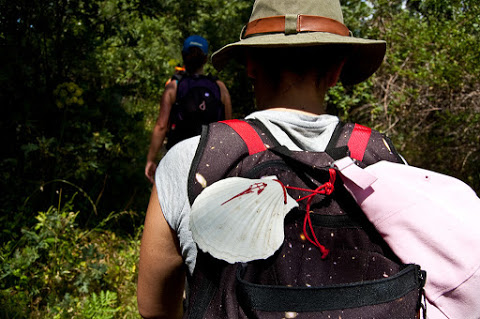
Jesus Perez Pacheco
That said, the film’s structure is peculiar. It tells the story of an almost 900-kilometer pilgrimage from St. Jean Pied de Port in the French Pyrenees to Muxia on Spain’s Atlantic coast, but concentrates to a huge degree on the first third of the journey. The almost 600 kilometres after Burgos barely merit a quarter of the film, with the 180 kilometres from Burgos to León across the Meseta getting a mere five-minute montage.
The Meseta is too easily overlooked. On the way to St. Jean I had met two Canadian brothers-in-law who were fairly sure they wouldn’t have time to walk the whole way to Santiago, but said they weren’t worried. They’d heard that the middle part of the Camino was flat and featureless and not worth seeing, and if need be they were happy to cover that stretch of the journey by bus. I heard similar things time and again during the first week: the middle bit of the Camino is boring and just something to get out of the way.
Far from being something to miss, however, I think that in some ways the vast shadeless plain of the Meseta is the purest part of the Camino. Its emptiness and endlessness enhance the sense of solitude many people seek on the Way, inviting us both to delve within and to look without. As such, perhaps more than any other part of the Camino, it nurtures contemplation, while at the same time fostering camaraderie.
All that, of course, was ahead of me when I made my sluggish way out of Burgos at almost eleven in the morning, having spent a weary morning eating breakfast and mending my bag — a strap was gradually tearing away so stitching was needed. The road from Burgos was both shorter and more scenic than the road in, and once we’d left the city’s suburbs we had a gentle if hot day’s walking to the tiny village of Hornillos. By the time we got there, however, with my ankle playing up and Bryony’s no better, everywhere was full. We decided to have dinner in a local bar before backtracking for five minutes or so to camp out beside a giant wall of hay bales.
The sky gradually darkened and the stars began to appear as we stretched out on our makeshift bed of foam mattresses and straw, and just as I’d been smiling at the constellations’ familiarity – so few things in Spain seemed the same as at home, but the stars were no different – the Kiwis remarked that they’d never seen the Great Bear before. It had never occurred to me that the sky could be an alien thing, and as I lay awake in the dark, my sleepsack tugged over my head in the hope of thwarting whatever mosquitoes the bats had missed, I couldn’t help but think that Chesterton had it right when he said that you can see something nine hundred and ninety-nine times and never see it at all.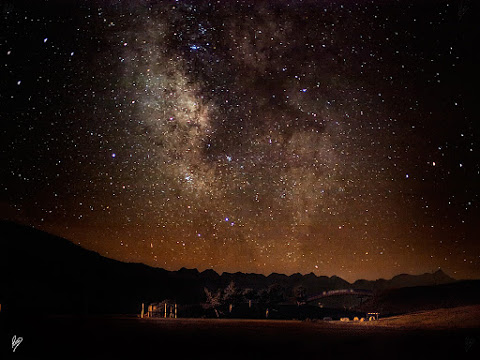
Paco CT
Without snorers to keep us awake or early risers to wake us before dawn, we slept far longer than we’d expected or intended, and so it wasn’t until past nine that we were on our way again. Our exploits earned us, for a few days anyway, the cumbersome nickname "the sleeping outside people", but I didn’t mind, as the episode had been not just refreshing, but liberating. I didn’t sleep outside again on the Camino, but I was usually prepared to if need be. Unlike so many people in the final crowded leg, I never worried about getting a bed for the night.
As the morning wore on, poppy-speckled wheat fields gave way to fields of golden barley, and then the road suddenly dipped, bringing us unexpectedly to Hosantos, a village that defied the trend of the Camino by buzzing with life in the middle of the day. Camino villages take the siesta seriously, and I’d lost count of the number of jokes people made about spaghetti westerns, Clint Eastwood, and tumbleweed.
Even in the relentless heat, trudging across the Meseta wasn’t nearly as arduous as the first week of the Camino, and on the flat ground it was even possible to strip my boot of the loose insole that had been causing my blisters. Still, the distance took a toll, and by the time we passed under the beautiful arches of the fourteenth-century monastery of San Antón, Bryony’s knee and foot weren’t capable of much more. We pushed on the last three kilometres or so to Castrojeriz, a sizeable village snaking around the foot of a hill surmounted with a ninth-century castle. Castrojeriz seemed to take the siesta to self-parodying excess. It took three quests for an open shop before Hannah had enough ingredients to improvize a delicious dinner.
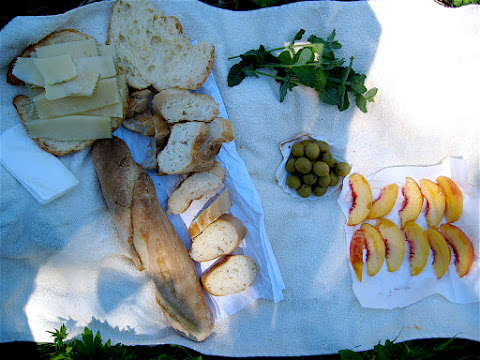
Neil Cummings
It was clear that Bryony couldn’t go on so Jeremy decided to accompany her back to London with a view to coming back and finishing the Camino next year. For our last day together Bryony went on by bus while Jeremy walked one last time with us. The morning’s climb to the ridge overlooking Castrojeriz was rewarded with spectacular views, and it wasn’t long before we’d passed the beautiful medieval albergue of Ermita de San Nicolás and had a late and uncharacteristically hearty breakfast at Itera de la Vega with Tom and Frances, a Canada-based Irish couple we’d first met in Burgos.
Walking on, we chatted with Davy and Jayne, a couple from Wales whose first date had seen them watching The Way together, and eventually reached Frómista where Bryony was waiting for us in the albergue courtyard. Spotting Jeanne outside, we had dinner together before I strolled with Canadian Steve, who had joined us just before Burgos, to the Gothic church a few minutes’ walk away. Mass was beautiful and ended with a pilgrim blessing where, with the Easter season now over, we sang the Salve Regina together for the first time on the Camino.
The next morning we said our goodbyes, having sat up talking as late as we could the previous night, and then set off, unlike most pilgrims, shunning the main road and following the river. We generally walked alone but stopped for lunch beside Villalcázar de Sirga’s huge Templar church. Just before two we reached Carrión de los Condes, described in the twelfth-century Codex Calixtinus, the first pilgrim manual, as "fortunate with bread and wine and meat and all fertility." This was high praise, given how the Codex elsewhere claims that "all fish, beef, and pork in Spain and Galicia make foreigners ill."
A group of the others strolled in later that afternoon, just in time for a multilingual singsong with the nuns at our albergue. Following Mass and our pilgrim blessing we all went for dinner, eschewing the standard pilgrim menu in favour of a selection of smaller dishes. I sampled the pigs’ ears and though I wasn’t impressed by them, it has to be said that they didn’t make me or any other foreigners ill.
After breakfast the next day, Jeanne and I set off together, strolling between fields of wheat and barley, but after a couple of hours I dropped back and spent the rest of the day walking and thinking on my own. Eventually I reached Terradillos de los Templarios, once a prominent Templar town but now little more than a cluster of dilapidated adobe buildings. There I found a friendly hostel where I spent most of my time chatting with Liz and Adam, an astoundingly well-travelled couple from Maine I’d been bumping into since San Juan de Ortega.
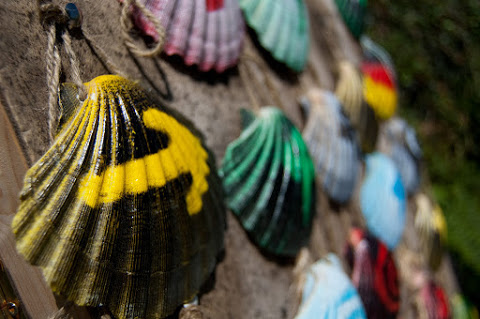
Jesús Pérez Pacheco
Several of the others had stayed in a different albergue, barely ten minutes behind us. They caught up the next morning just as Suus from Holland, another veteran of San Juan, was dancing in the courtyard while a Czech girl’s phone blasted The Proclaimers’ song "I’m Gonna Be," which had become something of a Camino anthem thanks to its line about walking five hundred miles. I walked on with Sorren, a medical student from California, the two of us reaching Sahagun in time for lunch. We waited for the others to catch up and then set off for the dry twelve kilometre stretch to Hermanillos de la Calzada.
Carlos and the Dublin-based Diana, Spaniards both, made better time than the rest of us, and by the time Sorren, Hannah, Chris, and I arrived the albergues were full. The hospitalero at the municipal albergue apologized and asked how we’d feel about emergency overflow accommodation, which turned out to be a self-contained five-room section including a sink, a balcony, power sockets, and wifi. We accepted without hesitation, musing later on how things just kept working out. "The Camino will provide," as the saying goes.
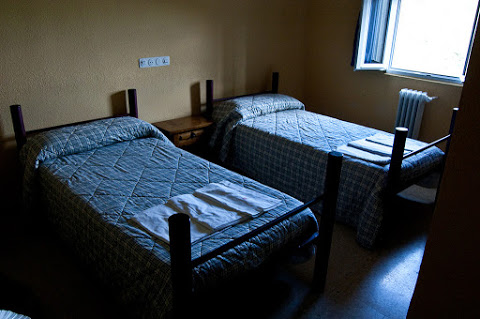
Jesús Pérez Pacheco
Suus joined us the next morning as we set off towards the Roman road, a 24-kilometre stretch with scarcely any shade and with nowhere to refill our water bottles. The wisdom of starting off with packs heavy with food and water paid off though, as none of us seriously struggled until about an hour before Mansilla de las Mulas. Spotting a tiny patch of shade we crouched together, pooled whatever we had left, and then hoisted our packs back into place to finish the day’s walk and get the last bunks in the albergue.
Our last day on the Meseta proved rather less gruelling – the 18 kilometres to León offering us several places to eat and drink as well as fruit stalls and a river in which to splash about – but somehow we reached León as exhausted and thirsty as ever. We relaxed and caught up with other pilgrims at a bar across from the cathedral that afternoon, but it wasn’t until the following day that I ventured into the cathedral itself. Left speechless by the stained glass, I understood why a friend had advised me before I set out that it was unmissable. For all its Gothic beauty, though, it felt somewhat like a museum. For spiritual nourishment I went instead to the other great church of León, that of St. Isidore, which houses the relics of the sixth-century polymath and where I could sit in prayerful silence with the Blessed Sacrament exposed before me.
After drinks in the Parador, the opulent state-owned hotel where Martin Sheen draws The Way’s Meseta montage to a close by treating his fellow pilgrims to a night’s accommodation, we made our way down to the main square to watch the football, the World Cup having begun the previous day. Afterwards, as I was heading back to bed for the night, I bumped into Eva, a Dutch girl with whom I’d celebrated my birthday over tapas in Logroño a fortnight earlier. I was startled to hear that she’d decided to go on by train. "My Camino is over," she smiled.
I never found out what it was she was seeking in Spain, or why it was that having walked from Lourdes to León she realised that her journey was complete, but it’s only now that it strikes me that that had been the first time I noticed anyone speaking of "their" Camino. It wouldn’t be the last.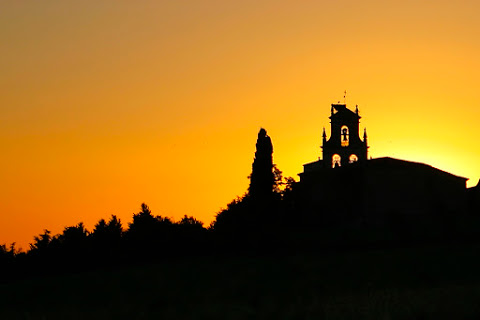
Alfredo Miguel Romero
